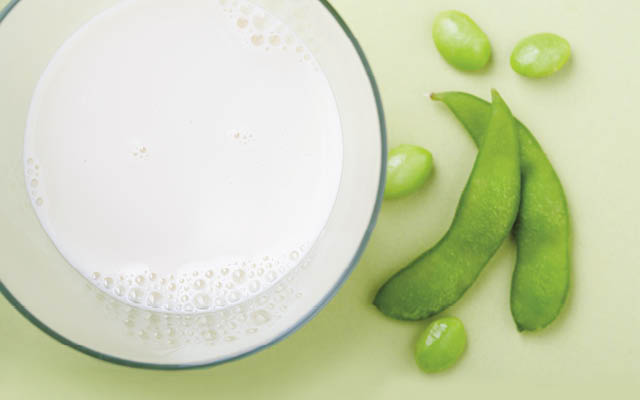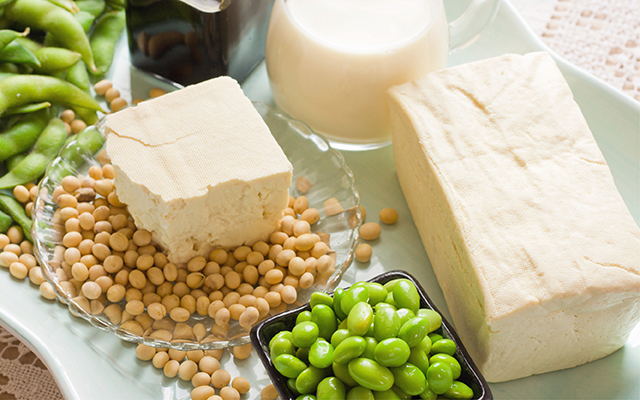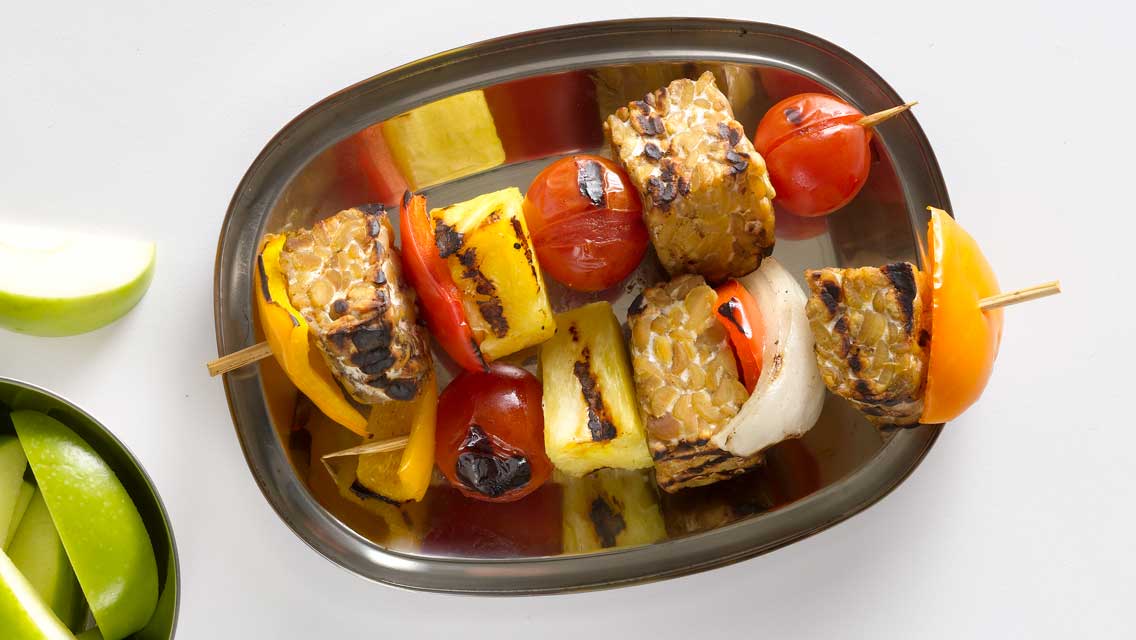The humble soybean has nourished humans for centuries. A rich source of protein, it also delivers a healthy mix of fiber, calcium, magnesium, and potassium. Decades of research have shown that people eating a traditional Asian diet — including dozens of soy-based foods, milks, pastes, and seasonings — have lower rates of heart disease, certain types of breast and colon cancer, and osteoporosis than those eating standard Western fare. Soy has come by its health halo honestly.
Yet, like many foods with proven health benefits, soy has been embraced by industrial food producers — and processed into myriad forms that have little, if any, visible relationship to the original bean. This is thanks in part to soy’s low cost (due to generous federal subsidies) and versatility, which make it irresistible to manufacturers that market to health-minded consumers.
These days, soy is a vital cog in America’s food-processing machine. Soybean oil is ubiquitous; soy flour appears in baked and packaged goods; soy lecithin, the waste product left over after soybeans are processed, is frequently used as an emulsifier; and processed soy protein is common in many foods, including veggie burgers, protein powders, and animal feed.
Because of all these hidden sources, most of us are eating more soy than we realize. And, as with any food, issues like digestive challenges, sensitivities, intolerances, and allergic responses can arise when we go overboard.
There’s also been debate around soy’s rumored links to breast cancer and hormone disruption.
So what’s the story? Is soy OK? Or is it best avoided?
“Soy is neither as good as the proponents say nor as evil as the critics claim,” says Mark Hyman, MD, director of Cleveland Clinic’s Center for Functional Medicine and author of Food: What the Heck Should I Eat? When deciding how much soy is safe to eat, he says, the key is to consider the best available evidence.
To that end, we reached out to several health experts to get their thoughts on soy. This is what they had to say.
Can Soy Increase My Risk of Breast Cancer?
“No study in humans has ever shown that food-based soy consumption increases your risk of breast cancer,” says Wendy Chen, MD, MPH, a breast oncologist at Dana-Farber Cancer Institute in Boston who researches soy and cancer.
You may have heard otherwise. The confusion can be traced to soy’s phytoestrogens, or plant-based estrogens. One particular group of these compounds, called isoflavones, resemble human estrogen, and they bind to estrogen receptors in the body. (Many breast cancers are estrogen-sensitive.) Yet decades of research have led health experts to conclude that isoflavones found in soy do not increase the risk of hormone-related cancers.
One reason Chen is confident about soy’s safety is that the topic has been exhaustively investigated. In one of the largest studies, the 2009 Shanghai Women’s Health Study, researchers looked at the well-being of 73,223 Chinese women and found that premenopausal women who consumed soy actually showed a reduced risk of breast cancer, and there was no significant association between soy consumption and the risk of postmenopausal breast cancer.
“I have no problem recommending that women eat soy foods in moderation as part of a healthy diet,” Chen says. “And that advice goes for breast-cancer survivors, too.”
There is an important caveat here: Studies that found no correlation between soy and increased risk of estrogen-sensitive cancers looked at minimally processed soy foods, such as tofu. They did not study soy-protein isolates — highly processed soy ingredients often used to add protein to nutritional bars or texture to meat substitutes, including textured vegetable protein (TVP).
“Soy-protein isolates are not natural; they are synthetic food ingredients made in a lab,” says Chen. “We know very little about their effect on humans, but in lab studies, soy-protein isolates have been shown to stimulate growth of breast-cancer cells.”|
What are the Signs of a Soy Allergy?
Soy is one of the most common food allergens and one of the top-five foods that trigger adult-onset allergies (the others are shellfish, tree nuts, fish, and peanuts). Most children will outgrow a soy allergy. Signs of allergy include itching in the mouth, hives, nausea, runny nose, and other asthma-like symptoms.
If you suspect a soy allergy, consider visiting an allergist for a skin-prick test or blood test. An elimination diet, however, may be the most reliable diagnostic, especially for sensitivities. (For details on elimination diets, see “The Institute for Functional Medicine’s Elimination Diet Comprehensive Guide and Food Plan.”)
“If you are allergic to soy, you’ll want to avoid it completely,” advises integrative physician Aviva Romm, MD. “But, if it’s a sensitivity rather than an allergy, you may want to work with your primary doctor to see if an elimination diet with later reintroduction is a possibility.”|
Which Forms of Soy are Best Avoided?
In general, try to avoid any soy that has gone through extreme processing. This means faux soy “meats” and their ilk, as well as the soy additives in numerous processed foods.
Soy-protein isolate is a powder made from soybeans that are heated and then exposed to a solvent-extraction process to remove the oils; that process often uses hexane, a known neurotoxin.
The dehydrated and defatted soybean flakes are then ground into a powder, which is used to make infant formula, meat alternatives, and other soy products, including many protein drinks.
Romm refers to these highly processed foods as “Frankensoy.” “Even when these foods are made from organic, non-GMO beans, highly processed soy foods are not part of a healthy diet,” she says.
“It’s best to stick with traditional, fermented forms, including miso, tempeh, and tamari, or organic tofu or edamame in small amounts.” (See below for more on these soy foods.)|
Should I Be Concerned About GMO Soy?
Yes. Organic soy is a better choice for several reasons.
Conventional soybean crops are more likely to be genetically modified. More than 90 percent of the U.S. soy crop is altered to tolerate Roundup, a Monsanto herbicide that contains glyphosate — a “probable human carcinogen,” according to the World Health Organization’s cancer-research division. Glyphosate residue has been found in GMO soybeans, and animal studies have also linked the chemical to disruptions in gut bacteria. “Glyphosate accumulation is a major concern for people and our planet,” says nutritionist Kathie Swift, MS, RDN, cofounder of the Integrative and Functional Nutrition Academy.
Organic soy is more nutrient-dense. For a recent study, scientists looked at 31 batches of soybeans from Iowa, including beans that were GMO, non-GMO conventionally grown, and non-GMO organically grown. They found that organic soybeans contained more total protein and fewer omega-6 fatty acids than conventionally grown and GMO crops.
Finally, GMO soy is a heavily subsidized crop, which is part of what makes it so cheap for producers of shelf-stable junk food.
“Choose whole, nonprocessed, non-GMO soy foods to obtain their full health benefits and to avoid supporting a federally subsidized industry that is, in part, driving the production of junk food,” Hyman recommends.|
What’s the Difference Between Fermented and Nonfermented Soy Foods?
Most traditional soy foods — such as tempeh, miso, and tamari — are fermented before they’re consumed. When foods are fermented, microorganisms are added that break down nutrients, making them easier to digest. In the case of fermented soy foods, the process separates soy’s dense protein into constituent amino acids.
Fermentation processes vary. To make tempeh, for example, soybeans are soaked, hulled, and boiled, then fermented with an established colony of microorganisms, much the way flour is mixed with a fermented starter to make sourdough bread. These microbes have health benefits of their own: They help predigest protein and they amplify soy’s antioxidants.
“Nutritionally, fermented soy foods edge out nonfermented soy foods because they have both pre- and probiotic potential, and digestibility is improved,” says Swift.
Plus, fermented soy foods are minimally processed, unlike most soy-based fake meats, says Hyman. “I have real concerns about processed soy, so stick to whole, organic, and — if possible — fermented soy foods.”|
Can I Still Enjoy Tofu, Even Though It’s Not Fermented?
Sure, in moderation. Just do your best to select organic, non-GMO tofu when possible, experts say.
Tofu is made by first soaking soybeans, grinding them with water, and removing the solids to produce soymilk. This milk is then cooked and combined with a coagulant, and the soft curds are placed into molds to drain, in a process similar to cheese making.
Because tofu is a traditional soy food — unlike, say, a soy hot dog — experts agree that a little now and then is fine. Still, it’s unfermented soy, so tempeh, which is fermented, is generally the better choice.|
Is Edamame a Good Soy Choice?
Hyman suggests this traditional Japanese snack is a fine way to enjoy some soy. Unlike a soy burger or soymilk, edamame is a whole food — so it gives you all the fiber, protein, and healthy fats the plant has to offer.|
Can Soy Challenge My Digestive System?
Yes. Like many plant foods, soybeans contain both phytate and oxalate, substances that help protect plants from predators — and that can trigger digestive difficulties for some people. These compounds are sometimes termed antinutrients because they can affect the body’s ability to absorb minerals from food. (For more on this, see “All About Antinutrients.”)
These antinutrients are another reason to choose fermented soy foods, because the fermentation process reduces phytate levels.
Oxalate appears to bind with minerals in the body and was once considered a risk factor for kidney stones, though phytate appears to inhibit the formation of calcium kidney stones.|
How Much Soy Can I Safely Consume?
First, don’t get too caught up in numbers. If you maintain a diverse diet with a good variety of plant foods and healthy protein sources, you can easily include a moderate amount of soy.
Some good rules of thumb: Stick with minimally processed varieties. Skip the soy burger and go for whole, fermented, or minimally processed soy foods, such as edamame, tempeh, natto, and organic tofu. All offer dense sources of high-quality protein as well as other nutrients, including iron and calcium, that are key to a well-rounded diet.
If you avoid animal foods, and soy is an important protein source, the same rules apply. Focus on keeping your diet diverse. Remember that many plant foods — legumes, seeds, and nuts — are also rich in protein. Aim for a balanced mix. “No one food is the eat all, be all!” says Swift.
This originally appeared as “Oh, Soy!” in the September 2019 print issue of Experience Life.




This Post Has 0 Comments